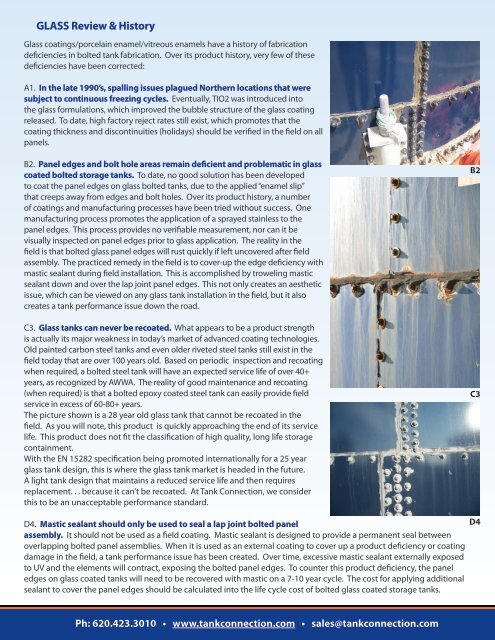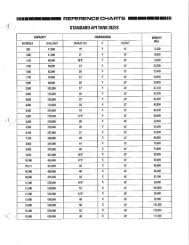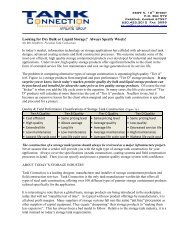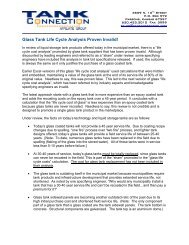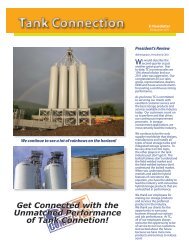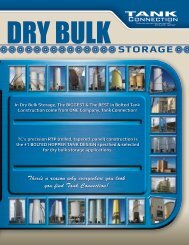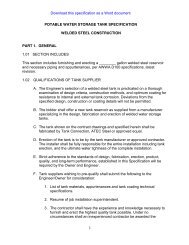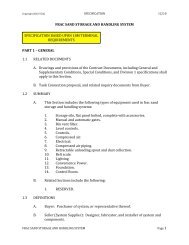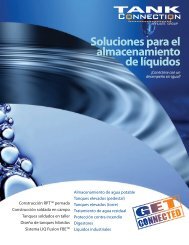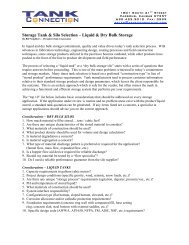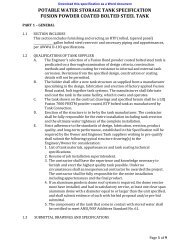A Stronger System Than Glass!
FUSION vs GLASS - Tank Connection
FUSION vs GLASS - Tank Connection
- No tags were found...
You also want an ePaper? Increase the reach of your titles
YUMPU automatically turns print PDFs into web optimized ePapers that Google loves.
GLASS Review & History<br />
<strong>Glass</strong> coatings/porcelain enamel/vitreous enamels have a history of fabrication<br />
deficiencies in bolted tank fabrication. Over its product history, very few of these<br />
deficiencies have been corrected:<br />
A1. In the late 1990’s, spalling issues plagued Northern locations that were<br />
subject to continuous freezing cycles. Eventually, TIO2 was introduced into<br />
the glass formulations, which improved the bubble structure of the glass coating<br />
released. To date, high factory reject rates still exist, which promotes that the<br />
coating thickness and discontinuities (holidays) should be verified in the field on all<br />
panels.<br />
B2. Panel edges and bolt hole areas remain deficient and problematic in glass<br />
coated bolted storage tanks. To date, no good solution has been developed<br />
to coat the panel edges on glass bolted tanks, due to the applied “enamel slip”<br />
that creeps away from edges and bolt holes. Over its product history, a number<br />
of coatings and manufacturing processes have been tried without success. One<br />
manufacturing process promotes the application of a sprayed stainless to the<br />
panel edges. This process provides no verifiable measurement, nor can it be<br />
visually inspected on panel edges prior to glass application. The reality in the<br />
field is that bolted glass panel edges will rust quickly if left uncovered after field<br />
assembly. The practiced remedy in the field is to cover-up the edge deficiency with<br />
mastic sealant during field installation. This is accomplished by troweling mastic<br />
sealant down and over the lap joint panel edges. This not only creates an aesthetic<br />
issue, which can be viewed on any glass tank installation in the field, but it also<br />
creates a tank performance issue down the road.<br />
C3. <strong>Glass</strong> tanks can never be recoated. What appears to be a product strength<br />
is actually its major weakness in today’s market of advanced coating technologies.<br />
Old painted carbon steel tanks and even older riveted steel tanks still exist in the<br />
field today that are over 100 years old. Based on periodic inspection and recoating<br />
when required, a bolted steel tank will have an expected service life of over 40+<br />
years, as recognized by AWWA. The reality of good maintenance and recoating<br />
(when required) is that a bolted epoxy coated steel tank can easily provide field<br />
service in excess of 60-80+ years.<br />
The picture shown is a 28 year old glass tank that cannot be recoated in the<br />
field. As you will note, this product is quickly approaching the end of its service<br />
life. This product does not fit the classification of high quality, long life storage<br />
containment.<br />
With the EN 15282 specification being promoted internationally for a 25 year<br />
glass tank design, this is where the glass tank market is headed in the future.<br />
A light tank design that maintains a reduced service life and then requires<br />
replacement. . . because it can’t be recoated. At Tank Connection, we consider<br />
this to be an unacceptable performance standard.<br />
B2<br />
C3<br />
D4. Mastic sealant should only be used to seal a lap joint bolted panel<br />
assembly. It should not be used as a field coating. Mastic sealant is designed to provide a permanent seal between<br />
overlapping bolted panel assemblies. When it is used as an external coating to cover up a product deficiency or coating<br />
damage in the field, a tank performance issue has been created. Over time, excessive mastic sealant externally exposed<br />
to UV and the elements will contract, exposing the bolted panel edges. To counter this product deficiency, the panel<br />
edges on glass coated tanks will need to be recovered with mastic on a 7-10 year cycle. The cost for applying additional<br />
sealant to cover the panel edges should be calculated into the life cycle cost of bolted glass coated storage tanks.<br />
D4<br />
Ph: 620.423.3010 • www.tankconnection.com • sales@tankconnection.com


